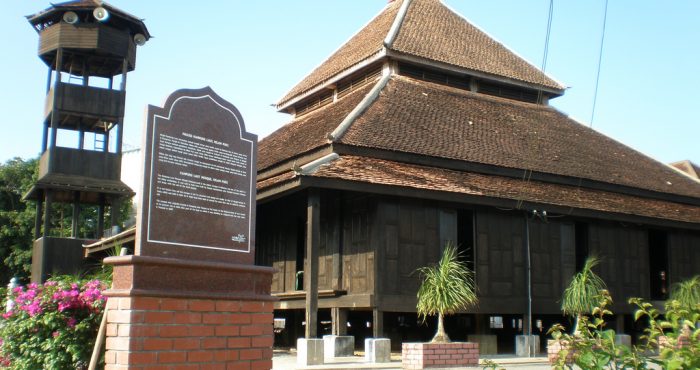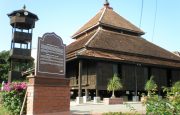Description
Masjid Kampung Laut is considered to be the oldest mosque in Malaysia, built in 1676. The mosque was originally located at Kampung Laut, in Tumpat district of Kelantan about two miles (3.2 km) downstream from the town of Kota Bahru. During its construction, the mosque is believed to sit on at least three-quarters of a mile (1.6 km) from the riverside of the Kelantan River and near the seashore. In 1967, Masjid Kampung Laut was moved from its original site to Nilam Puri, Kota Bahru, Kelantan. This was due to the recurring floods at its original location, and the Malaysian Historical Society felt the mosque was no longer safe there. The major floods of December 1966 partly destroyed the mosque and left it in a dangerous condition, thus it could not be used. For this reason, renovation works were carried out in November 1967 by a group of Kelantan Malay craftsmen.
This mosque is influenced by the Nusantara style. The floor plan is square in shape. The roof of the mosque is a three-tiered Meru roof (pyramidal roof). The end of ridge cap is known as ekor itik in Kelantanese dialect, and it symbolises a dragon. The way the dragon is symbolised in this mosque is that it was formed into something called som that are located at the four corners of the mosque’s roof. Som is divided into three parts that are known as the head, body and tail. The shape of buah buton at the tip of the roof is the result of refinements made in the shape of a stupa.
The uniqueness of this mosque is the existence of balai lintang (foyer hall) and wakaf orang kaya (dignitary’s gazebo) which were built in the 1950s by Orang Kaya Hussein. Balai lintang is located in
front of the main prayer hall opposite to the mosque’s main entrance. Balai lintang was built in 1908. The minaret, wakaf orang kaya and ablution pond are located on the right side of the main entrance of the mosque. The old minaret that had collapsed was originally located at the front of the mosque.
Originally, this mosque, which was built about 300 years ago was just a simple building in the form of a wakaf with four columns. It was more of a place of worship and meditation rather than of a proper mosque as we know today. The roof is thatched while the floor was made of nibung (mangrove palm). Initially, the mosque had no walls. Later, the mosque was enlarged; the thatched roof was replaced with roof tiles from Pattani and the nibung floor replaced with chengal wood about three inches thick which is also used for the walls. The walls of the mosque are similar to the common Kelantanese Malay traditional houses at that time, which is known as janda berhias walls.




There are no reviews yet.